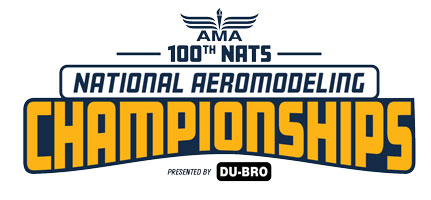By Rick Pangell
Adding to the experience, talk about changing weather conditions … north, south, east, west … just pick a direction, as the drift moved around all day. Changing your launch site is probably pretty easy if you are self-contained but moving the headquarters trailer requires some help. AMA does a marvelous job of helping to do just that.
Early in the morning was coold(!), requiring folks to pull out the old jacket. This was a far cry from the heat of the previous day, and the prospect of rain was a change too. To sum things up, the weather was surprisingly nice … cool with a lot of lift.
Tuesday’s events were well contested, and the typical Free Flight events were flown. The fliers buckled down after all of the conversation from Monday, July 25, settled down.
Unique events such as ROW and Jetex added to the fun. ROW is one of those events where the rules challenge the flier and the model. One would think that covering your model in plastic would be a slam-dunk decision, but tissue-covered models kept up a tradition from yesteryear. When splashed a bit, the aircraft showed that water and tissue covering has some issues. However, that didn’t stop the flying … well … the attempted flying, but some of the more experienced fliers showed us that they have mastered the event. What to watch was young Caleb Finn, who figured out that wading in the pond was just as much fun as flying.
Jetex has been dominated by Chris Matsuno for so many years that I can’t remember when he didn’t. I figure he has a world’s supply of fuel and fuse to make it many more.
The Mulvihill trophy is the longest-running and oldest Free Flight award, and last year, the Nats hosted descendent family members of Lord Mulvihill for the presentation. This year it was won by Canadian flier Patrick Mackenzie. His model was a vintage built-up trussed stick fuselage. He gets kudos for building it, let alone excellent flying.
About the time all the usual events were flown, the glider pen started being populated … then the drizzling rain came in, adding to the challenge. My OT Cat flew all over the place on launch and then I looked at my stabilizer … it looked like a potato chip. The drizzle did a number on some of the models, but patience in waiting for lulls in the rain and the eventual sunshine resulted in some great flying.
After the day’s flying and awards, the E-20 event was flown. For those not familiar with it, the model and rules are pretty basic. It’s a 20-inch electric-powered model, with a 20-second motor run for a 90-second max. Flyoffs are a 10-second motor run and 120 seconds max. This may seem kind of backward, but as usual, technology improvements in electric components have produced models that can far exceed the rules. Watching some models skyrocket to altitudes that should take 90 seconds to fall is impressive, but not a given max. Conventional model designs performed nicely too.
Wednesday’s flying has NFFS Rubber 1 Design and the beginning of the FAC model flying.
Flightline scores are obtained by using the following web link:
Thermals!!
















